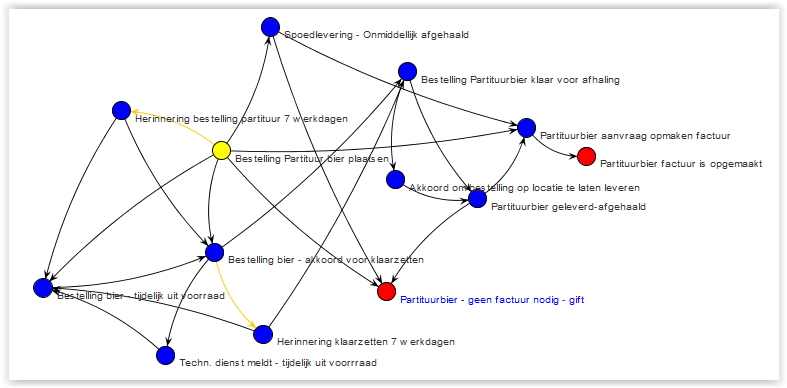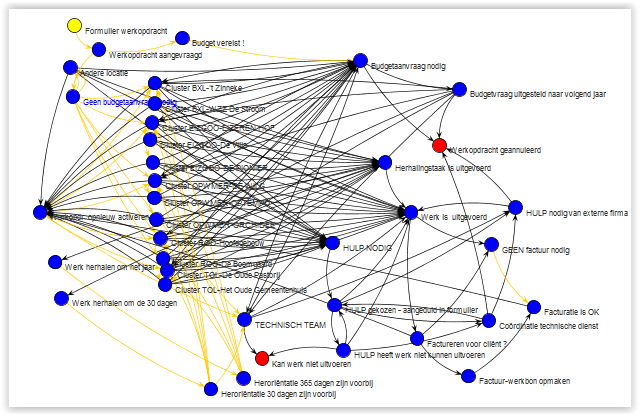What if an organisation wants to start working in a more decentralised manner when most of the staff have no idea about all the different processes that are taking place in the company? Additionally, what do you do if the staff’s interest isn’t in ICT but taking care of people and they have almost no contact with the central management location? While the company board has big expectations of the staff at the various locations, they themselves don’t know who to turn to for more specific information about a task and the chance to make an incorrect decision is acute. How can the company delegate trust to the decentralised locations and still follow the business practice without losing supervisory oversight?
Zonnelied vzw
Zonnelied vzw is such an organisation, providing help and support for vulnerable and disabled people. Located in Belgium, it is rather a large company of its kind - let’s call it a care provider - that has grown from 1 location up to 5 large areas with 15 locations. It provides services to 400 clients with a staff of almost 400.
On top of this there is high staff turnover, between 40% to 50% each year; at any of the locations. The staff often change not only because of contracts coming to an end, but also changes of location. This makes it very difficult to keep everybody updated about; the business structure; the knowledge to know how to act; what choice to make, and informing the right people of the right information is big challenge.
Vibe and the organisation
After a few years of hard labour and searching for the right approach I convinced 2-3 people of the possibilities that Vibe could offer by solving their problem with the help of a form and a workflow (WF). Convincing the management that Vibe was a long term solution for many of our processes took a lot of time and effort. It was helped by initially taking on small highly specific tasks.
Once the first workflows were successful, the approach to persuade policy changed and more and more forms and workflows followed.
Diving deeper into it, some workflows used the same default approach, but often another approach was needed, depending on the results we wanted to achieve.
Workflows are now very important tools in the operation of the company covering a wide range of activities. Three different examples are described below to indicate their usefulness.
Workflow 1: BEER
When the company reached an anniversary it decided to celebrate by having its own brand of beer - after all, Belgians are known for their fine beers.
So why did we need a Vibe workflow for this? Initially there was no control:
- Over stock
- Who could provide beer
- Whether an invoice was needed and was it actually created and paid (gift or personal use of the staff)
- Reminders when nobody acted if an order was placed.
Figure 1 shows the workflow that resulted for this task; quite straight forward with a small number of stages and transitions. (yellow indicates the starting point, blue indicates intermediate states, while red indicates termination of the workflow)

Why was it built this way? One person should be able to control the whole process, especially the supervision over orders and invoices, while several functions were involved: logistics, technical service, reception, accountant, brewery and the person who placed the order for the beer.
Notifications are sent when an action has to be taken, for example if there is no reaction to an order in x-time, or the beer is ready to collect, or if an invoice has to be generated.
Workflow 2 : KEYS - for access to locations by contract staff
Why did we need a workflow for this? Because issuing keys to new staff or staff that changed location was difficult. Keys were illegally duplicated or keys were not returned at the end of a contract. This was a major safety/security concern for the company.
How does it work? The HRM department fills in the basic fields of the form when a new staff member signs a contract. Required fields are, name, start date of contract, end date of contract and location. The warden at the relevant location, fills in the rest.
When a contract is coming to the end then 7 days before the end, a notification is sent to the HRM department. If the staff member has a new contract or are moving location then they modify the form; if not they don’t do anything and 3 days before the end of the contract the warden receives a notification to arrange for the return of the keys.
Figure 2 shows the resulting workflow. It appears more complex than it is because the same actions are dealing with multiple locations.

Why was it built this way? There is just one big form because staff can change location and come back to the same location later on.
From the viewpoint of the form the warden of a location sees a simplified view, by using “show only when”.
There is no real end to the workflow, only when somebody retires (or dies). Otherwise somebody could always come back to work in the organisation.
Workflow 3: Staff handyman on location
Why did we need a workflow for this? Decentralising means that some centrally located staff were moved to different locations. Keeping contact with the team is important. Supervision of tasks and budget was required. Handymen are supported in their decisions and can opt for self-management.

How does it work? Everybody can fill in a form for to request a task. If the handyman needs assistance, he asks for help and a notification is send for the help he needs.
We keep the form simple. The handyman on the location is the owner of the task. To reduce the number of modifications, others can make notifications or add comments.
The handyman can decide if an invoice is needed for a client.
Why was it built this way?
- The Budget control department asked for the possibility to separate the task into two categories; either “Yes, you can go ahead” or sending it to a folder to wait until the supervisor/financial management gives his approval.
- Task management is by the location handyman.
- There is an automatic reminder if a job has not been started after x-time.
- Re-opening a job should be possible.
The organisation and Vibe now in 2019
Vibe is now the leading software for projects and teams that transcend a function, so access control for a mix of functions is needed. We have found that by using Vibe:
- It enables trust and lets people work as much as possible independently without intervention.
- It tries to ensure that: the people behind the processes have to make up as little as possible and decisions are made faster than before, errors are eliminated and secure information is stored in the system, ready to look up if necessary.
- It keeps control over the budgets and the legislation rules.
- Supervisors can occupy themselves with other tasks.
- The staff are in charge of their own activities and can work faster and independently.
Overall problems
During the introduction of Vibe it has become clear that success is due to:
- Changing the mindset from using email - which is a personal way of communicating - into using our own forms or tasks.
- Realising that not all staff are proficient or have access to the application at all times.
- In translating a process into the different steps that are needed - The Vibe administrator/developer should know the organisation and its processes in detail or be able to translate a process into the different steps that are needed.
- The administrator has to know the possibilities of Vibe.
Key points
There are many other things that we have learnt while implementing Vibe workflows. Key points are:
- Don’t try to include everything: put in the most important and essential steps. Keep it simple.
- Adapt fields in the form if you need them for your workflow.
- Hide as many fields as possible at a particular stage in the workflow, so the users do not get confused with which field to fill in.
- With a diverse group of people, go for the simplest solution so everybody can handle it, even if that means that the workflow in the background is more complex.
- Educate the staff regularly. Find people who can give backup to the ICT department, to provide the first line of support to the users.
- For the management of the workflow, to make it easier later on:
- Use groups (in AD or eDir) as much as possible and bring them into VIBE by using LDAP. If staff changes occur, you don’t have to change it in the workflow but do it by changing membership of the group.
- Put the access control as much as possible into the folders and the workspaces instead of in the workflow.
Micro Focus Vibe is a powerful software application with many capabilities. This article just indicates some of the possibilities that forms and workflows provide companies, especially if they wish to operate in a decentralised way. Vibe provides all the collaboration tools that are required.
This article was first published in OH Magazine, Issue 44, 2019.2, p23-25.


